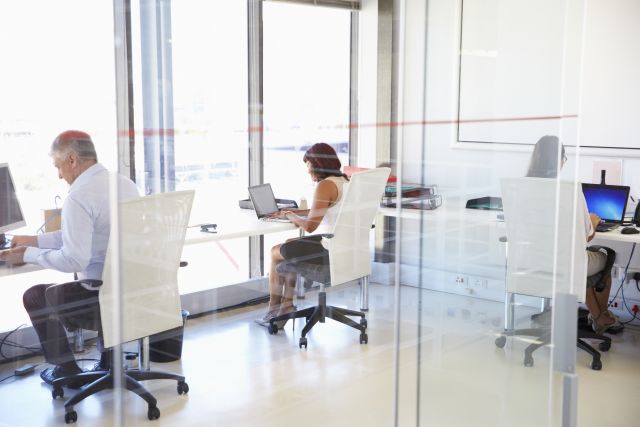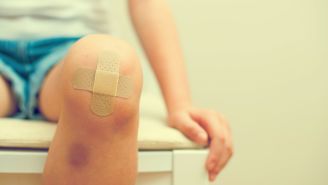Updated on May 9, 2022.
When a good part of your waking hours are spent in an office, it’s important to be aware of certain hazards, and what you can do to reduce your chances of injury.
Whether it’s eyestrain from long days on the computer or back problems from slipping on a wet break room floor, take these precautions.
1. Slips and trips
Cedric McCord, MD, of Doctors Hospital of Augusta in Georgia says the most common office injuries he sees are related to slipping or tripping. “I've done this a long time, and I see this problem over and over,” he says.
Cleaners and wax treatments will lead to slippery floors, and drink spills can be a major hazard. So, if the floor is glistening, avoid the area or walk slowly. Tangled or exposed cords can cause you to trip, as well. Any electrical cords—think power cords for laptops and phones—should be secured away from the floor.
And McCord can’t stress the importance of observation enough. “There’s a term that we used in the Army when I was there for 29 years: situational awareness. If you’re going to sit down, make sure the chair, especially when it has wheels, is where you think it is, or you will plop down on the floor,” he says. These fallls can lead to leg and back injuries, he adds.
2. Poor ergonomics
Many office jobs require spending long hours at a desk on a computer, where repetitive motions (typing, using a mouse, etc.) and a poor workstation set-up can lead to bad posture, pain, fatigue, numbness, and weakness.
A good working environment should include a chair that provides lower back support, allowing you to sit with your hips bent at a 90-degree angle and your feet flat on the floor. You should be able to hold your wrists and forearms parallel to the floor, and desk and chair edges should be rounded or padded.
Check the Occupational Safety and Health Administration’s online guide for setting up your workstation to adjust your equipment and avoid discomfort. If parts of your workstation can’t be altered and you believe they’re causing you pain, talk to your manager or Human Resources department to see if it can be evaluated.
3. Eyestrain and dry eyes
When you’re glued to your computer for hours on end, your eyes can become strained, dry, and irritated. To ease these symptoms, make sure your monitor is placed just below eye level and about 20 to 26 inches from your face. Increase font size on documents, which can make them easier to read, and keep eye drops at your desk for quick relief.
McCord also recommends getting up once an hour for a few minutes and doing something that doesn’t involve your computer. During this time, give your eyes the chance to focus on things at various distances.
Bright office lighting can cause strain, as well. If possible, dim overhead lighting in your area. To prevent screen glares, the National Safety Council (NSC) recommends pointing your computer screens away from windows, closing blinds, or using a glare reduction filter.
4. Strained back
You knew that certain physically active jobs, like those in construction, can take a toll on your body. But you can pull muscles even at the office.
“Overexertion is still a problem because folks have a tendency to want to move things,” McCord says. “Folks are picking up boxes of paper, or a delivery arrives at the office, and people want to move things around.”
McCord advises that if something is heavy, especially if it weighs more than 40 pounds, don’t try to move it yourself. Get help or see if there’s a lifting assistance device available.
When you do bend over or reach to pick something up, use proper form. Avoid lifting from a standing position, and don’t bend at your waist. Instead, make sure the object is close to your body and bend or lift with your legs. Keep your back straight and try not to twist once you’re holding the object.
5. Lacerations
McCord says he sometimes sees patients who have cut themselves trying to open a box with scissors or box cutters.
“When you get a cut, it should be evaluated and you should make sure your tetanus status is up to date,” McCord says. “A tetanus immunization is only good for about 10 years, and most folks that I talk to can't remember the last time they've had one.” See a healthcare provider if your wound is:
- To your face
- More than 1/2-inch long
- Deep in your skin
- Flapping open at the edges
- Bleeding profusely
If a visit isn’t called for, clean the cut with soap and water (not hydrogen peroxide or alcohol) and cover it with a sterile dressing or bandage to avoid infection. Change it at least once a day.
6. Space heater hazards
“No one needs to get burned by a space heater,” says McCord. “It happens, but it shouldn’t happen.” If you keep an electric space heater at your desk, make sure you:
- Keep it at least 3 feet away from anyone or anything that may burn
- Place it on a flat surface
- Get the kind with a thermostat, overheat protection, and an automatic shut-off if it tips over
- Plug it directly into the wall—don’t use an extension cord
- Turn it off when not in use
On the days when you’re using the heater, set a reminder in your phone or leave a sticky note on your desk so you’ll remember to power it down. If your cubicle neighbor uses a space heater, check it when you leave, or remind them to turn it off to prevent burns or fires.







